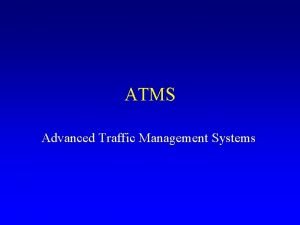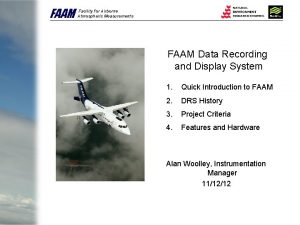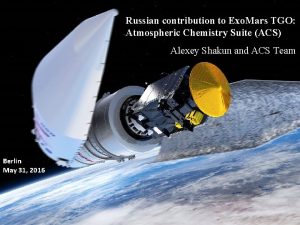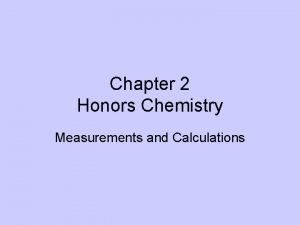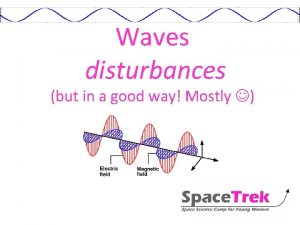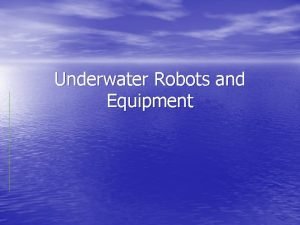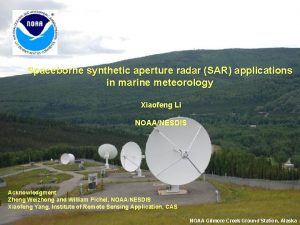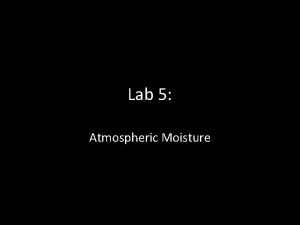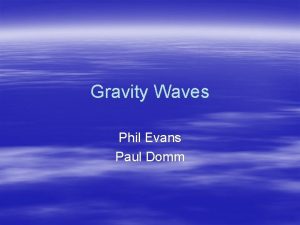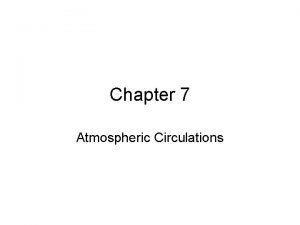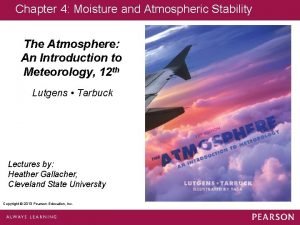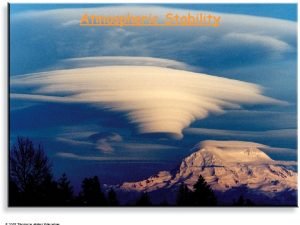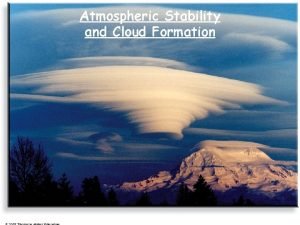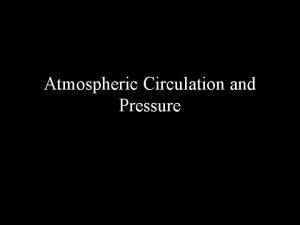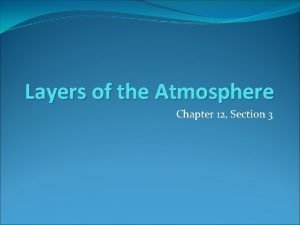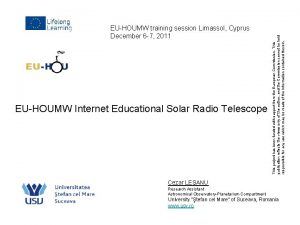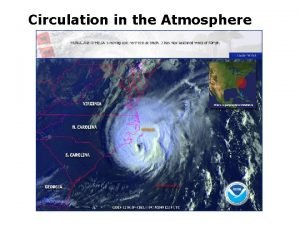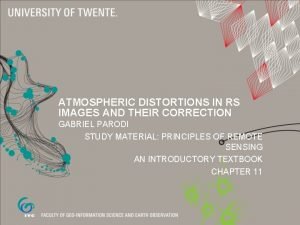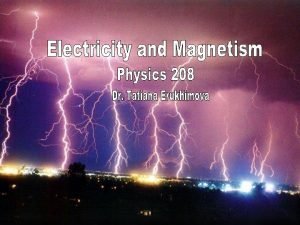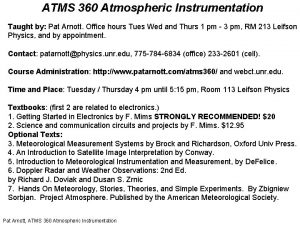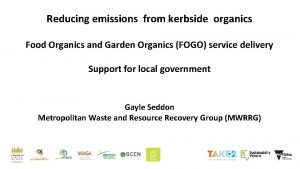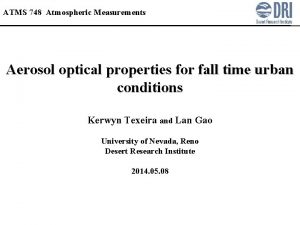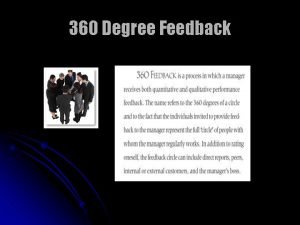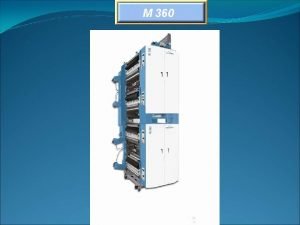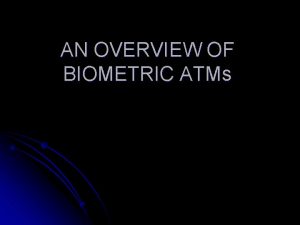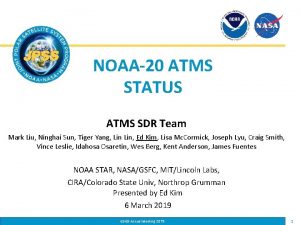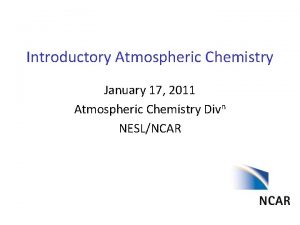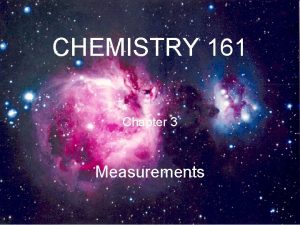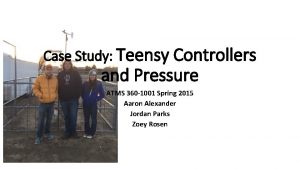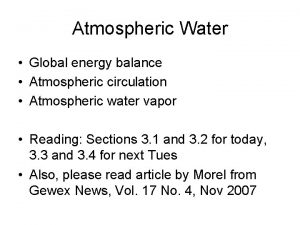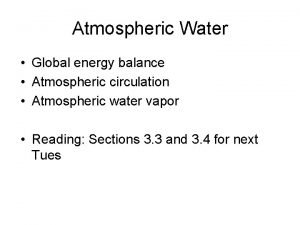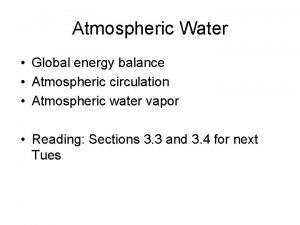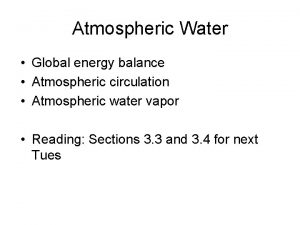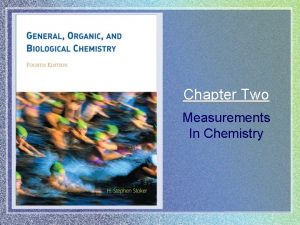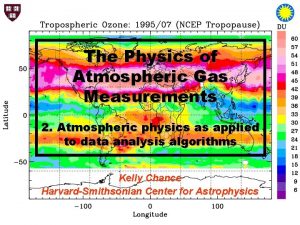Atmospheric Chemistry Measurements Organics in Air ATMS 360































- Slides: 31

Atmospheric Chemistry Measurements – Organics in Air ATMS 360

Organic Chemistry - Carbon Compounds • Carbon - C, atomic number 6, molecular weight 12 • Electron configuration: 1 s 22 p 2 • Tetravalent, covalent bonds – 4 single bonds (sp 3); 2 double bonds (sp 2) one triple (sp) plus one single bond • Other atoms: hydrogen, oxygen, nitrogen, sulfur, halogens (Cl, F, Br)

Compounds • • • Alkanes – Cn. H 2 n+2 (CH 4, C 2 H 6, etc) Alkenes – Cn. H 2 n (C 2 H 4, etc) Alkynes - Cn. H 2 n-2 (C 2 H 2) Aromatic compounds (C 6 H 6, benzene) Polycyclic aromatic hydrocarbons - PAH (naphthalene, C 10 H 8)

Models CH 3 – CH 3 Ethane Methane

Ethylene (Etene) Pentane CH 3 -CH 2 -CH 3

CH 3 CH 2 OH Ethanol Benzene

Sources of Organics in Air • Anthropogenic: – – Incomplete combustion of fossil fuels Biomass burning Industrial processes Cooking • Natural sources – Biogenic emissions (from vegetation) – Volcanic – Evaporation of sea spray • Atmospheric reaction products (from VOC, SVOC), secondary organic aerosol (SOA)

Fossil fuels Complete combustion: Cx. Hy + (x + y/4)O 2 e. g. C 5 H 12 + 8 O 2 x. CO 2 + y/2 H 2 O 5 CO 2 + 6 H 2 O Incomplete: CO, soot, organics and (in air) NOx

Biomass Burning Biomass: cellulose, hemicellulose, lignin, resins

Other sources - testing Residential wood Combustion Meat cooking

Secondary Organic Aerosol (SOA) • SOA processes are studied in photoreactors • European photoreactor (EUPHORE) in Valencia, Spain, is one of the largest (200 m 3) and the bestequipped outdoor simulation chamber in the world • We are studying atmospheric transformation of diesel emissions under the influence of sunlight, ozone, hydroxyl radicals that occur during transport in ambient air

Volatile, Semi-Volatile and Particulate Matter Organic Compounds (VOC, SVOC, PM) Vapor pressure ranges: VOC: > 102 Pa (10 -1 Torr) SVOC: 102 and 10 -6 Pa; (10 -1 and 10 -8 Torr) PM: < 10 -6 Pa (10 -8 Torr)

Organic Aerosol • Organic aerosols are solid or liquid particles suspended in the atmosphere containing organic carbon • Semi-volatile organic compounds (SVOC) distributed between gas and particle phases – reversibly condensable • Particle associated organics – complex mixture, incorporated into/onto particles; includes condensed SVOC and non-volatile organic compounds

Criteria Pollutants – National Ambient Air Quality Standards (NAAQS) • • Particulate Matter (PM) Ozone NOx SO 2 CO Lead (Pb) Ambient standards established by the US EPA and reviewed every 5 years

Why Particulate Matter? • Health effects: particulate matter (fine, PM 2. 5 and to lesser degree, coarse PM 10 -2. 5) has been associated with adverse health effects at low-to-moderate concentrations • NAAQS exist for PM (since 1971): – current (since 1997): PM 2. 5 annual 15 µg/m 3 and 24 -hr 65 µg/m 3; PM 10 annual 50 µg/m 3 and 24 -hr 150 µg/m 3 _ announced in September 2006: PM 2. 5 annual 15 µg/m 3 and 24 -hr 35 µg/m 3; PM 10 annual only • Climate change • Visibility problem (Haze Rule)

Average Ambient PM 2. 5 Composition in Urban Areas EPA STN network

Average PM 10 -2. 5, PM 2. 5, and PM 0. 1 composition at EPA “supersite” in Los Angeles, CA, 10/2001 to 9/2002 US EPA OAQPS PM Staff Paper, June 2005

Hazardous Air Pollutants (HAPs) • Full list – 188 compounds, most of them organics • The short list – 33 air toxics, most prevalent in urban area • No ambient standards – regulation of emissions from sources


Measurement Methods • Collection of VOC and aerosol samples followed by off-site laboratory analyses • VOC collection: stainless steel SUMMA canisters, Tedlar bags • PM and SVOC: Filters followed by solid adsorbents. Extraction with organic solvents in the laboratory

Operational Definitions of SVOC and PM Associated OC Filter-Adsorbent (FA) Filter-Filter. Adsorbent (FFA) Denuder-Filter. Adsorbent (DFA) Electrostatic precipitator (EA) F A F F 1 A F D E A A

Analysis - Chromatography • Chromatography is a separation method that relies on differences in partitioning behavior between a flowing mobile phase and a stationary phase to separate the components in a mixture • Gas-liquid chromatography (GC) –mobile phase is gas (He, N 2, H 2) • Liquid chromatography (LC) – mobile phase is liquid. High performance liquid chromatography (HPLC) utilizes high-pressure pumps to increase the efficiency of the separation.

Gas Chromatography (GC) Columns: • Packed columns, 1 -10 m long, 2 -4 mm ID (filled with solid support material coated with liquid or solid stationary phase) • Capillary columns, 10 – 60 m long, <1 mm ID (the inner column walls are coated with stationary phase)

Detectors for GC and HPLC • Gas Chromatography detectors: – – – Flame Ionization (FID)- hydrocarbons Thermal Conductivity (TCD) - universal Electron Capture (ECD) – halogenated organics Photoionization (PID) - aromatics, olefins Fourier Transform Infrared (GC-FTIR) – all organics Mass Spectrometer (GC-MS) – any species • HPLC Detectors: – – UV-VIS absorption spectroscopy Photo diode-array UV-VIS Fluorescence MS (LC-MS)

Mass Spectrometry measures the mass-to-charge ratio (m/z) of charged particles to find the composition of a sample by generating a mass spectrum representing the masses of sample components. Mass Spectrometer: Sample Inlet High vacuum Ion Source Mass Analyzer Detector Data Analysis

Ion Source • Ionization methods: Electron Impact (EI), Chemical Ionization (CI), Field Ionization (FI), Field Desorption (FD), Fast Atom Bombardment (FAB), Matrix-Assisted Laser Desorption/ Ionization (MALDI), Electrospray Ionization (ESI), and others. . • EI (unimolecular): bombarding neutral analyte M with high energy (70 e. V) electron beam M + e- M+· + 2 e • CI (bimolecular): M interacts with ions from reagent gas M + [BH]+ [M+H]+ + B (proton transfer) M + X+ [M+X]+ (electrophilic addition) M + X+ M+· + X (charge exchange) M + X +· [M-A]+ + AX (anion abstraction)

Principle of mass analysis When the ion beam experiences a strong magnetic field perpendicular to its direction of motion, the ions are deflected in an arc whose radius is inversely proportional to the mass of the ion (mass-to-charge ratios m/z). Lighter ions are deflected more than heavier ions. By varying the strength of the magnetic field, ions of different mass (m/z) can be focused progressively on a detector fixed at the end of a curved tube

Mass Analyzers • Types of mass analyzers: – magnetic sector (deflection of ion beam, separation by momentum); – linear quadrupole (4 rod electrodes, the pair of opposite rods are each held at the same potential composed of DC and AC component; a mass spectrum is obtained by monitoring the ions passing through the quadrupole filter as the voltages on the rods are varied); – quadrupole ion trap (three-dimensional RF quadrupole field to store ions within defined boundaries); – time-of-flight (TOF, uses the differences in transit time through a drift region to separate ions of different masses ).

Advances in Mass Spectrometry • "Aerosol -MS" is the measurement in real-time of the aerosol composition using a mass spectrometer. Almost always the particle size is measured simultaneously with the composition. Two approaches: – Single particle MS –Laser desorption-ionization MS. Example: Aerosol Time of Flight MS (ATOFMS, available commercially from TSI, Inc. ) – Thermal desorption aerosol MS. Example Aerodyne Aerosol MS, available commercially (http: //cires. colorado. edu/~jjose/ams. html#Info_Aerosol. MS).

Aerodyne Aerosol Mass Spectrometer (AMS) Particle Beam Generation Aerodynamic Sizing Particle Composition Quadrupole Mass Spectrometer Chopper Thermal Vaporization & Electron Impact Ionization TOF Region Aerodynamic Lens (2 Torr) Particle Inlet (1 atm) Turbo Pump 100% transmission (60 -600 nm), aerodynamic sizing, linear mass signal. Jayne et al. , Aerosol Science and Technology 33: 1 -2(49 -70), 2000. Jimenez et al. , Journal of Geophysical Research, 108(D 7), 8425, doi: 10. 1029 / 2001 JD 001213, 2003.

Aerodyne Aerosol Mass Spectrometer (AMS) 100% transmission (60 -600 nm), aerodynamic sizing, linear mass signal. Jayne et al. , Aerosol Science and Technology 33: 1 -2(49 -70), 2000. Jimenez et al. , Journal of Geophysical Research, 108(D 7), 8425, doi: 10. 1029 / 2001 JD 001213, 2003.
 Atms traffic control
Atms traffic control Heritage
Heritage Facility for airborne atmospheric measurements
Facility for airborne atmospheric measurements Midwest organics recycling
Midwest organics recycling Atmospheric chemistry suite
Atmospheric chemistry suite An introduction to atmospheric physics
An introduction to atmospheric physics Measurements in chemistry
Measurements in chemistry Hubungan air dengan tanah
Hubungan air dengan tanah Functional groups ib chemistry
Functional groups ib chemistry Inorganic vs organic chemistry
Inorganic vs organic chemistry Atmospheric opacity
Atmospheric opacity Atmospheric perspective watercolor
Atmospheric perspective watercolor Atmospheric diving system
Atmospheric diving system Atmospheric gravity waves
Atmospheric gravity waves Penn state meteorology jobs
Penn state meteorology jobs Lab 5 atmospheric moisture
Lab 5 atmospheric moisture Pressure at different altitudes
Pressure at different altitudes Atmospheric gravity waves
Atmospheric gravity waves Single cell model of atmospheric circulation
Single cell model of atmospheric circulation Atmospheric stability
Atmospheric stability Unstable equilibrium meaning
Unstable equilibrium meaning Atmospheric stability
Atmospheric stability Circulates air between 60-90 latitudes
Circulates air between 60-90 latitudes Stellar heaven
Stellar heaven Section 1 atmospheric basics continued answers
Section 1 atmospheric basics continued answers Atmospheric opacity
Atmospheric opacity Atmospheric circulation
Atmospheric circulation Atmospheric distortion correction
Atmospheric distortion correction What is a weather variable
What is a weather variable Earths layers definition
Earths layers definition Hadley cells
Hadley cells A first course in atmospheric thermodynamics solutions
A first course in atmospheric thermodynamics solutions
